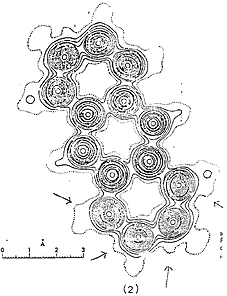by, Sithamalli K. Balasubramanian - Ph.D.
- 3. Non-bonding
or inert areas called the i-surfaces which are important in anions
and are colored blue, or black.
The order of bond strengths is, b-surface bonds > q-surface bonds. There could be bonds involving b-b surfaces or b-q surfaces and q-q surfaces. The first type of bonds are the most stable, the second are of intermediate order of stability and the last the least stable.
The major isotopes of the elements carbon 12C, silicon, 28Si and boron, 11B are used as the basis for the study. The minor isotopes are dealt with in the last part of the paper under implications.
Carbon: 12C is assigned structure (1) which is a ten nucleon tetrahedron with two nucleon projections on tetrahedral faces. The structure is built from a six nucleon octahedron by adding six more nucleons at octahedral face-centres. Though all the six centers are equivalent the combinations of bonding patterns derived from them are not equivalent as will be apparent from figure 1.

Fig. 1 - Carbon Structure.
Carbon could have covalency of 4, 5, and 6. The last two would lead to overcrowding of bonded electron pairs and hence are less frequently encountered than the first. The quadrivalent carbon could have three bonding patterns, namely, the tetrahedral, the square pyramidal or square planar and the inverted bonds. These are formed respectively by using four b-surfaces or two b-surfaces and two q-surfaces or one q-surface and three b-surfaces of the same tetrahedral face.
The difference from the quantum model is obvious in that two 1s2 electrons are considered in the quantum theory to be in an inner shell and are not available for bonding interactions. In our model all the six bonding sites are equivalent whilst their combinations in sets of four show differences in stability and preferential formation.
The electronic spectra should be dealt with as a separate problem. Our idea is to draw attention to the fact that structural chemistry does not fit in easily with the quantum theory and ...top
needs the radically different approach given here. Every new structure like, for example, the double bond with tetrahedral carbons, needed a modification, or induction of new concepts into the quantum theory demonstrating its inadequacy. Even the well-known phenomenon of an asymmetric carbon is a matter of debate among the quantum theorists.
The tetrahedral pattern is the most stable of the three patterns since the mutual repulsion between bonded electron pairs would be the least in that pattern. The square planar would come next and the inverted bond would be the last in order of stability. The three patterns are discussed in detail later.
Null areas in an atom: The obvious consequence of postulating specific bonding sites in an atom is that there should be null areas which do not have electron densities. These were called the i-surfaces earlier. Even the q-surfaces would be nominal null areas but might make their presence felt in certain circumstances as low electron density contours.
Confirmation of this deduction comes from the published electron density contour diagram (2) of anthracene wherein the q-surfaces appear as bulges (marked by arrows) in the carbon atoms of the terminal rings {ref.5}. The model (3) of the terminal ring shows the q-surfaces exactly corresponding to bulges in the electron density contour diagram. The degree of correspondence is striking given the qualitative and revolutionary nature of the assumptions made by us. The conventional view has no explanation for the bulges as the authors of the paper attribute them to vague “thermal agitation”.

Fig. 2 - Electron density diagram of Anthracene.